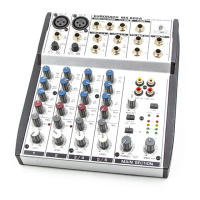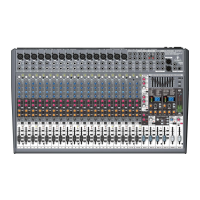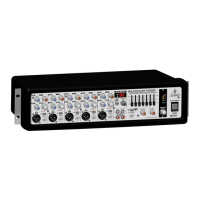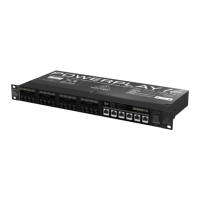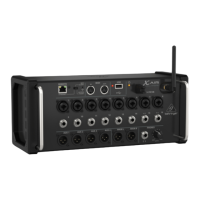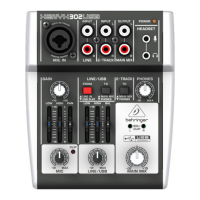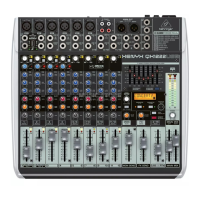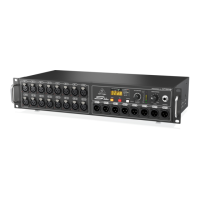Do you have a question about the Behringer EURORACK MX1804X and is the answer not in the manual?
Warnings about electrical shock, fire hazards, and protecting the appliance from moisture.
Explains the mixer's configuration, signal routing, and overall architecture.
Preparatory information covering mixer metering, power supply unit, warranty, and packing.
Detailed explanation of mono input channel features like input level, EQ, and aux sends.
How to set input levels using GAIN, PFL/SOLO, and Peak LEDs on mono channels.
Description of the three-band EQ and low-cut filter on mono channels.
Explanation of the mono aux sends and their routing options on channels.
How to route, fade, and mute signals within the mono channels using faders and buttons.
Details the features and operation of stereo input channels, including level, EQ, and aux sends.
Explains the routing of stereo channels, including balance control and its effect on stereo panning.
How to use inserts on channels/buses and overview of the main section controls like aux sends.
Describes the functionality of the aux return and FX return inputs for extra line signals.
Details the main mix/solo/PFL bargraph meters and status LEDs for signal monitoring.
Explains the CHANNEL MODE switch for Solo-In-Place and PFL assignments.
How to connect and use the 2-track input and output for recording and playback.
How to use the monitor section for headphones and main monitors with different sources.
Explanation of the Alt 3-4 bus routing and its use as a submix or for specific routing.
Describes the 7-band graphic equalizer for main mix adjustments to room acoustics or taste.
Details the integrated 24-bit stereo multi-effects processor and its 32 presets.
How to select and connect microphone, line, and stereo inputs correctly.
Steps for initializing channels (Gain, EQ, LOW-CUT, PFL) before setting gain levels.
How to audition signals and set up channel levels using PFL, GAIN, and inserts.
Procedures for normalizing desk settings to default conditions before or after sessions.
Steps for initializing a multitrack recording setup to ensure proper input monitoring.
Guidelines for setting optimal recording levels for digital and analog formats to avoid distortion.
How to set up the mixer for live performances with simultaneous 2-track recording.
Guidance for using the mixer in a MIDI project studio environment, focusing on line inputs and cue feeds.
Explains the benefits and use of a patchbay for studio cabling and signal routing.
Details common patchbay configurations and module types, including wiring schemes.
Describes the "parallel" patchbay mode for splitting signals to multiple destinations.
Explains the "half-normalled" patchbay mode, useful for insert paths without interrupting signal flow.
Describes the "normalled" patchbay mode where inserting a plug interrupts the rear path.
Explains the "open" patchbay mode for connecting devices without inputs, saving space.
An example configuration for organizing patchbays in a studio setup, connecting various equipment.
Discusses common cabling issues like earth loops and how to avoid them for clean signal paths.
Methods for expanding the mixing system by combining mixers or adding extra line inputs.
Discusses the art and science of mixing audio signals, including EQ philosophy.
In-depth explanation of equalization techniques and their application for sound shaping.
How to optimize gain settings for signal clarity, dynamics, and avoiding distortion.
Guidance on connecting the mixer to the power supply unit and ensuring proper grounding.
Details on making various audio connections, including unbalanced and balanced signals, and phantom power.
Step-by-step guide for modifying mono channels to make Aux send 2 pre-fader.
Warnings about electrical shock, fire hazards, and protecting the appliance from moisture.
Explains the mixer's configuration, signal routing, and overall architecture.
Preparatory information covering mixer metering, power supply unit, warranty, and packing.
Detailed explanation of mono input channel features like input level, EQ, and aux sends.
How to set input levels using GAIN, PFL/SOLO, and Peak LEDs on mono channels.
Description of the three-band EQ and low-cut filter on mono channels.
Explanation of the mono aux sends and their routing options on channels.
How to route, fade, and mute signals within the mono channels using faders and buttons.
Details the features and operation of stereo input channels, including level, EQ, and aux sends.
Explains the routing of stereo channels, including balance control and its effect on stereo panning.
How to use inserts on channels/buses and overview of the main section controls like aux sends.
Describes the functionality of the aux return and FX return inputs for extra line signals.
Details the main mix/solo/PFL bargraph meters and status LEDs for signal monitoring.
Explains the CHANNEL MODE switch for Solo-In-Place and PFL assignments.
How to connect and use the 2-track input and output for recording and playback.
How to use the monitor section for headphones and main monitors with different sources.
Explanation of the Alt 3-4 bus routing and its use as a submix or for specific routing.
Describes the 7-band graphic equalizer for main mix adjustments to room acoustics or taste.
Details the integrated 24-bit stereo multi-effects processor and its 32 presets.
How to select and connect microphone, line, and stereo inputs correctly.
Steps for initializing channels (Gain, EQ, LOW-CUT, PFL) before setting gain levels.
How to audition signals and set up channel levels using PFL, GAIN, and inserts.
Procedures for normalizing desk settings to default conditions before or after sessions.
Steps for initializing a multitrack recording setup to ensure proper input monitoring.
Guidelines for setting optimal recording levels for digital and analog formats to avoid distortion.
How to set up the mixer for live performances with simultaneous 2-track recording.
Guidance for using the mixer in a MIDI project studio environment, focusing on line inputs and cue feeds.
Explains the benefits and use of a patchbay for studio cabling and signal routing.
Details common patchbay configurations and module types, including wiring schemes.
Describes the "parallel" patchbay mode for splitting signals to multiple destinations.
Explains the "half-normalled" patchbay mode, useful for insert paths without interrupting signal flow.
Describes the "normalled" patchbay mode where inserting a plug interrupts the rear path.
Explains the "open" patchbay mode for connecting devices without inputs, saving space.
An example configuration for organizing patchbays in a studio setup, connecting various equipment.
Discusses common cabling issues like earth loops and how to avoid them for clean signal paths.
Methods for expanding the mixing system by combining mixers or adding extra line inputs.
Discusses the art and science of mixing audio signals, including EQ philosophy.
In-depth explanation of equalization techniques and their application for sound shaping.
How to optimize gain settings for signal clarity, dynamics, and avoiding distortion.
Guidance on connecting the mixer to the power supply unit and ensuring proper grounding.
Details on making various audio connections, including unbalanced and balanced signals, and phantom power.
Step-by-step guide for modifying mono channels to make Aux send 2 pre-fader.
| Type | Analog |
|---|---|
| Channels | 18 |
| Microphone Preamps | 4 |
| Inputs - Mic Preamps | 4 |
| Stereo Inputs | 2 |
| EQ Bands | 3 |
| Aux Sends | 2 |
| Returns | 2 |
| Phantom Power | Yes |
| USB Interface | No |
| EQ | 3-band EQ |
| Faders | 60 mm |
